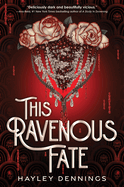
In Hayley Dennings's visceral, haunting debut, This Ravenous Fate, two best friends-turned enemies--one of them a vampire--must work together to investigate a spree of murders in 1926 Harlem. This queer Black YA fantasy simmers with tension and darkness as it explores grief, trauma, betrayal, and desire rooted in the Black experience during the Jazz Age.
North American colonists unethically experimented on Black and brown people in the 1600s. These victims of the "curiosity of the New World" were "prodded, drugged, bled, and tortured" to the point where some of them became vampires, or "reapers." Though the humans thought they had killed all the reapers, one--Valeriya--evaded their guns and bonfires. She created more reapers over the centuries, forming her own clan in New York City's Harlem, where she still rules during the Roaring '20s. This burgeoning reaper population has led to humans needing to protect mortal life. Tobias Saint, a steelmaker, began manufacturing and distributing bullets made from a special alloy that permanently eradicates reapers. He then expanded his business to include reaper-hunting services, forming the Saint empire.
Tobias's daughter, Elise, was sent to Paris after being attacked by reapers multiple times, including an assault by her childhood best friend and newly turned reaper, Layla Quinn. Five years later, Elise, now 18, returns to celebrate the 10-year anniversary of her family's company. Elise expects her father to name her heir to the business but is shocked when he hands the reins to her younger sister, Josi, whose noninteraction with reapers makes her less likely to be a target of the monsters.
Layla was greatly influenced by the Saints growing up, so she feared reapers and cursed them with the "same fury a Christian might condemn the devil." But her parents wanted to work with the reapers. Five years ago, they secretly planned to meet with Valeriya to help form a peace agreement. Elise, fearing for their lives, told her father about their plans, thinking he would convince them not to go. Instead, feeling threatened by the Quinns, he spread lies about their intentions, incensing the reapers. They attacked and killed Layla's parents and then turned Layla. Now, as a member of Valeriya's clan, she blames Elise's family for her "ruination"--every good part of her life has been stolen by her reaperhood and she is eager to exact revenge.
Elise and Layla are forced to come together, though, when two Saint associates and a 15-year-old boy are murdered, and Layla is the prime suspect. Elise convinces her father to install her as heir and let her take the lead on the investigation, sure she can get Layla to admit to wrongdoing. Layla agrees to work with Elise to prove her innocence, but also to show that something more sinister might be happening. The boy found dead alongside the associates had been a newly turned reaper Layla met just days earlier. Now, in death, he is human again. Could it be the result of a reaper bite antidote that one of the associates was working on? Or is something more dangerous lurking among them? Elise and Layla's investigation takes them all over town, including a cold and desolate morgue and a festive gala. The young women desperately try to uncover the evil spreading throughout the city, all while grappling with their deep attraction to one another.
Debut novelist Hayley Dennings deftly braids together vampire lore, anti-Black racism, and female rage in This Ravenous Fate, an immersive, atmospheric first book in a duology. The foundation of Dennings's story is its solid exploration of racism. She roots the dawn of reaperdom in slavery and uses reapers as physical representations of anti-Blackness and the spreading poison of racism. This fictional account of the Black experience is paired with smart commentary on the realities of being a Black person in the 1920s in the U.S., with discussions about the exploitation of Black entertainers, the minimalization of Black victims, and the lack of humanity afforded to Black people. This melding of fantasy and reality comes together to form a riveting, plausible world.
Through such worldbuilding, Dennings also creates an ominous and enveloping atmosphere with gruesome yet alluring imagery. Setting this story during the Harlem Renaissance is a smart choice, not only for the rich history the time period presents but also for the lavishness and chaos of the era, whether it be socialites gossiping behind feathered fans or politicians conferring with gangsters. Dennings skillfully contrasts this colorful spectacle of "twisted pearls" and "spilling cash" with macabre scenes filled with graphic depictions of violence: "Nails tore through fabric and flesh, separating ribs until they cracked beneath the force." The dichotomy of visuals is enthralling.
Dennings's characters are dynamic and complex. Elise experiences anxiety, guilt, and OCD stemming from familial pressures and past traumatic events. She witnessed violence and malice at a young age, and she is inherently vulnerable because she's Black in a "country where strength was expected of her, and anger made her a target." It's no wonder she finds "security in her numbers and rituals." Dennings masterfully treats Elise's emotional state with care and thoughtfulness, eliciting sympathy for and understanding of her panic attacks and compulsive episodes. Layla, a creature that doesn't inherently warrant tenderness or affection, maintains enough humanity to be an enticing character. Dennings infuses her with an understandable and relatable longing for love as well as a deeply rooted terror and aversion to being "damned."
Layla and Elise's shared experiences unequivocally draw them together, regardless of their mixed feelings about their connection. Whether it's the "thorny thrill" of Layla's words stirring in Elise or the buzz of Layla's skin from Elise's "essence of fatal attraction," Dennings creates a palpable tension between them that is bewitching and compelling.
This Ravenous Fate is a captivating, blood-soaked story centered on the Black experience in the early 20th century that glimmers with thrills and opulence. --Lana Barnes

